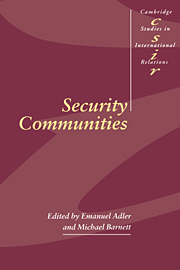Book contents
- Frontmatter
- Contents
- Notes on contributors
- Acknowledgements
- Part I Introduction and theoretical overview
- Part II Studies in security communities
- 3 Insecurity, security, and asecurity in the West European non-war community
- 4 Seeds of peaceful change: the OSCE's security community-building model
- 5 Caravans in opposite directions: society, state and the development of a community in the Gulf Cooperation Council
- 6 Collective identity and conflict management in Southeast Asia
- 7 An emerging security community in South America?
- 8 Australia and the search for a security community in the 1990s
- 9 The United States and Mexico: a pluralistic security community?
- 10 No fences make good neighbors: the development of the US-Canadian security community, 1871–1940
- 11 A neo-Kantian perspective: democracy, interdependence and international organizations in building security communities
- Part III Conclusions
- Index
- CAMBRIDGE STUDIES IN INTERNATIONAL RELATIONS
8 - Australia and the search for a security community in the 1990s
Published online by Cambridge University Press: 30 October 2009
- Frontmatter
- Contents
- Notes on contributors
- Acknowledgements
- Part I Introduction and theoretical overview
- Part II Studies in security communities
- 3 Insecurity, security, and asecurity in the West European non-war community
- 4 Seeds of peaceful change: the OSCE's security community-building model
- 5 Caravans in opposite directions: society, state and the development of a community in the Gulf Cooperation Council
- 6 Collective identity and conflict management in Southeast Asia
- 7 An emerging security community in South America?
- 8 Australia and the search for a security community in the 1990s
- 9 The United States and Mexico: a pluralistic security community?
- 10 No fences make good neighbors: the development of the US-Canadian security community, 1871–1940
- 11 A neo-Kantian perspective: democracy, interdependence and international organizations in building security communities
- Part III Conclusions
- Index
- CAMBRIDGE STUDIES IN INTERNATIONAL RELATIONS
Summary
Introduction
When Karl Deutsch and his colleagues proposed the concept of “security community” their focus was on groups rather than single states. Given the necessarily plural nature of “community,” it might be wondered how a single-country case study might assist in the retrieval of Deutsch's concept of security community. We argue that the case of Australia is indeed useful, because of the country's shifting location in global politics. While such changes are by no means unique, few political communities have as self-consciously sought to “relocate” themselves, in economic, diplomatic, and security terms as Australia did in the 1980s and 1990s. Between 1983 and 1996, the Australian Labor Party (ALP) governments of Bob Hawke and Paul Keating pursued an undisguised “push into Asia.” While this hardly represented an Australian “defection” from the West, as Samuel Huntington put it, there can be little doubt that the ALP was seeking to “move” Australia from being a European/American-oriented community to being a nation in, and of, the Asia Pacific.
In addition, however, we argue that the Australian case offers analytical insights into foreign policy transformation. We will argue that a combination of post-imperial history, geo-strategic location, and national politico-economic development provided the impetus for the pursuit of a liberal internationalist foreign policy that can foster the growth of security communities in the post-Cold War era.
Australia, we suggest, has increasingly become a state in international politics that sits uneasily between two worlds in security terms.
- Type
- Chapter
- Information
- Security Communities , pp. 265 - 294Publisher: Cambridge University PressPrint publication year: 1998
- 2
- Cited by

